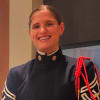This project is now in update mode. Check back regularly to see how things are progressing.
Support Skipper Crew!
Meet Skipper Crew:
Skipper Crew is composed of approximately 25 cadets from amongst the regiment, representing all battalions and ROTC organizations. The group is divided equally amongst all four year-groups with first-year cadets being new members, freshly inducted after their spring tap. First-year cadets primarily train on the proper procedures associated with firing and maintaining Skipper, while also serving as safety officers, maintaining a safe perimeter around Skipper and keeping an eye out for any safety hazards. Sophomores and juniors take on the majority of the effort to maintain and operate Skipper, while also fulfilling various administrative and logistical functions. They are led by the Chief of Smoke, the top junior cadet on Crew. The seniors, with the exception of the Gun Captain, take on an advisory and mentor role to the underclassmen, stepping in to provide support and manpower when needed. The entire crew is led by the Gun Captain, a senior cadet held in high regard within the regiment and on Skipper Crew. This cadet is ultimately responsible for all activities related to the cannon, its operation, and the Crew’s activities.
In order to join Skipper Crew, cadets undergo a rigorous tap process consisting of public engagement development and physical fitness, academic, and practical knowledge assessments. Being a member on Crew is a tremendous honor, and the Crew very much holds their place in the long tradition of Skipper at Virginia Tech in high regard.
How can you help:
We need your help to ensure Skipper Crew has funds needed to support the operations and continue to BOOM loudly and proudly at Virginia Tech events. Expenses include:
- Regular maintenance and upkeep of Skipper cannon, truck, and trailer.
- Supporting supply costs for Skipper operations
- Train Skipper Crew cadets for safe handling of Skipper
- Transportation of Skipper to events and activities
History of Skipper:
Each year, dating back to 1918, Virginia Tech (then VPI) would meet rival Virginia Military Institute (VMI) in a football game played on Thanksgiving Day. VMI had a cannon named “Little John,” which would fire every time the Keydets scored, while their cadets chanted, “Where’s your cannon?”
In the early 1960s, Homer “Sonny” Hickam ’64, Alton “Butch” Harper ’64, and George Fox ’64 tired of the smack talk and decided to fire back. Armed with a plan to “build the biggest cannon the world had ever seen,” the trio collected extra brass from cadets’ uniform items as well as shell casings from the firing range, which they would melt for the gun. Foundry owner Paul Huffman, an alumnus of the Corps of Cadets, cast the cannon at no charge.
When the cadets learned of the assassination of President John F. Kennedy, this gave birth to the name Skipper, which had two meanings: first to honor the fallen president, as he had been a skipper in the U.S. Navy, and also as an inside joke for the cadets (Skipper was a nickname for senior cadet privates who had gotten in trouble). At the 1963 VMI vs. Virginia Tech game, 50 cadets hauled Skipper from underneath the bleachers and fired the gun.
The cannon suffered a blowout in 1982, so in 1984, Paul Huffman Jr. ’78, whose father had cast the original Skipper, offered to fabricate a new cannon at no charge. Skipper II is based on a Civil War cannon. Its design compares to a 3-inch ordnance cannon, which is 70 inches long and weighs about 800 pounds.
$5
Cost of Gas for Skipper Truck
Cost of gas for Skipper truck to transport Skipper for parades, football games, and other events.
$10
Cost of Each Cannon Fire
Each time Skipper is fired there is a cost associated with the powder and materials to make the BOOM.
$25
Food for Skipper Crew Cadets
Skipper duty days often exceed 8 hours on football weekends. Cadets have no stadium access and must provide their own food/hydration throughout the day.
$50
Regular Maintenance on Skipper
Supports regular and routine maintenance on Skipper cannon.
$100
Cost of Training Per Cadet
Covers the cost of training for cadets on Skipper Crew to ensure they are properly trained and understand procedures of firing Skipper.
$250
Cost of Game Day Operations
Covers the cost of game day operations for Skipper cannon and truck (fuel, shot cost, cleaning, maintenance) and provides meals/drinks to entire Skipper Crew (10+ cadets).
$500
Operating Cost and Tools
Fund all new implements (pick, ram, sponge) for Skipper, cover the cost of black powder, support annual maintenance costs on truck and trailer, and fund minor Skipper repairs.
$1,000
Refurbish Skipper's Tires
Skipper's tires were originally designed pre-Civil War to last only 30 day. Skipper's have lasted 40 years with regular care and maintenance. However, the time is now to start planning for their replacement and refurbishment.






